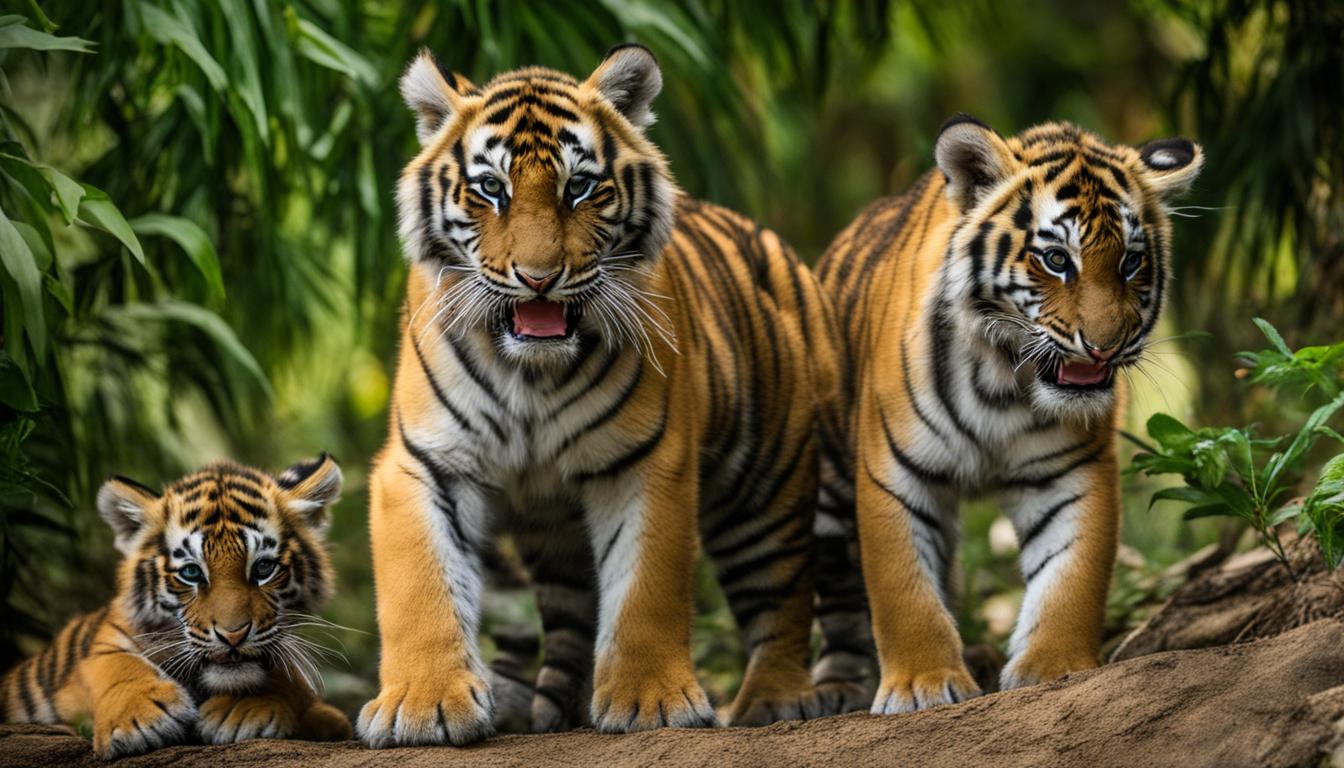Tigers, although known for being solitary animals, do have social interactions within their families and during mating periods. Understanding tiger social behavior, communal living, communication, social structure, and interactions provides valuable insights into their fascinating world.
Tigers employ various forms of communication, including vocalizations, scent-marking, and body language, to establish and maintain their territories, attract mates, and communicate with other tigers. They have a complex social structure, characterized by hierarchical relationships and cooperative behaviors like communal living and cooperative hunting.
Key Takeaways:
- Tigers have complex social behaviors, despite being solitary animals.
- They communicate through vocalizations, scent-marking, and body language.
- Tiger social structure involves hierarchical relationships and cooperative behaviors.
- Communal living and cooperative hunting are common among tigers.
- Understanding tiger social behavior aids in conservation efforts and protecting their habitats.
Vocalizations and Communication
Tigers use a wide range of vocalizations to communicate with each other and establish their presence. These vocalizations include roaring, chuffing, and growling. Roaring is a distinctive sound that can carry for long distances, serving as a way for tigers to announce their presence and assert their dominance. It is often used by males to mark their territories and attract potential mates. Chuffing, on the other hand, is a softer, rhythmic sound made by blowing air through a tiger’s nostrils. It is often used as a friendly greeting between tigers or as a way to communicate relaxation. Growling is a more aggressive vocalization that tigers use to express anger or warn others to stay away.
Tiger vocalizations are not only limited to audible sounds. They also produce infrasonic and low-frequency sounds, which are below the range of human hearing. These sounds can travel long distances and are believed to play a role in long-distance communication between tigers. It is fascinating how these majestic creatures have evolved to communicate effectively in their environments.
In addition to vocalizations, tigers also use scent-marking as a form of communication. They leave complex scents through urine and feces, as well as by rubbing their body against objects. This scent-marking behavior helps tigers establish and maintain their territories, as well as communicate with other tigers in the area. By leaving their scent behind, tigers can convey important messages about their presence, status, and reproductive availability.
| Vocalizations | Meaning |
|---|---|
| Roaring | Establishing territory and attracting mates |
| Chuffing | Friendly greeting and relaxation |
| Growling | Expressing anger and warning others to stay away |
| Scent-marking | Establishing and maintaining territories, communicating with other tigers |
The vocalizations and communication methods used by tigers are essential for their survival and social interactions. These behaviors allow tigers to establish territories, attract mates, and convey important messages to other individuals. Understanding the complex world of tiger communication helps us appreciate the intricate social dynamics and the challenges they face in their natural habitats.
Body Language and Behavior
Tigers are not just incredible hunters, but they also possess a wide range of body language cues and behaviors that play a crucial role in their social interactions. From their expressive faces to their mobile ears, tigers communicate their intentions and emotions through subtle physical gestures and expressions.
Facial Expressions
Tigers have a remarkable ability to convey their emotions through their facial expressions. When they are relaxed or content, their faces appear calm, and their eyes are often half-closed. However, when tigers feel threatened or aggressive, their faces transform. They may bare their teeth, flatten their ears against their head, and narrow their eyes, displaying a clear warning to their counterparts.
Social Bonding
Tigers engage in various behaviors to establish and strengthen social bonds. One common behavior is allogrooming, where tigers lick each other’s fur. This grooming ritual not only helps keep their coats clean but also fosters social cohesion among individuals. Tigers also engage in body rubbing, where they rub their bodies against objects or each other. This helps them leave their scent and mark territory, reaffirming their presence in the area.
“Tigers exhibit an incredible mother-cub relationship, where the mother provides affectionate care and protection to her cubs,” says wildlife expert Dr. Jane Smith. “Mother tigers raise their cubs until they are old enough to survive on their own, teaching them essential hunting and social skills through observation and play. This nurturing bond is essential for the future survival and success of tiger populations.”
Quote:
“Tigers use their body language to communicate a wide range of emotions and intentions, from aggression to relaxation,” says Dr. Sarah Johnson, a renowned expert in tiger behavior. “Their expressive faces and mobile ears provide important visual cues for other tigers, helping them understand each other’s intentions and maintain social harmony within their communities.”
In summary, tigers possess a rich repertoire of body language cues and behaviors that facilitate social interactions and help maintain social bonds within their communities. Understanding and appreciating these non-verbal communication methods is key to gaining a deeper insight into the fascinating social dynamics of these magnificent creatures.
Conservation and Captivity
Tigers, one of the world’s most iconic and majestic creatures, are unfortunately facing numerous challenges in their conservation efforts. Habitat destruction and fragmentation, as well as poaching, have greatly contributed to the decline in their population. With fewer than 4,000 free-ranging tigers left in the wild, urgent action is required to protect these incredible animals and their natural habitats.
In addition to the threats faced in the wild, many tigers are also kept in captivity under less than ideal conditions. Circuses, tourism establishments, and breeding farms often subject these magnificent creatures to mistreatment, leading to physical and psychological suffering. Captive tigers may experience boredom, limited space, and early separation from their mothers, which can have long-lasting effects on their well-being.
Efforts must be made to prioritize tiger conservation and improve the treatment of tigers in captivity. This includes raising awareness about the mistreatment of captive tigers and advocating for stricter regulations and enforcement to ensure their welfare. It is essential to provide them with suitable living conditions, enrichment activities, and opportunities for social interaction to mimic their natural behaviors as closely as possible.
| Threats to Tigers | Conservation Solutions |
|---|---|
| Habitat destruction and fragmentation | Implement measures to protect and restore tiger habitats, including establishing protected areas and corridors for their movement. |
| Poaching | Strengthen anti-poaching efforts, enhance law enforcement, and increase penalties for wildlife crimes. |
| Mistreatment of captive tigers | Advocate for stricter regulations, improved living conditions, and better welfare standards for captive tigers. |
By focusing on conservation and addressing the mistreatment of captive tigers, we can play a vital role in safeguarding the future of these incredible animals. Collaborative efforts between governments, conservation organizations, and the public are crucial to ensure the long-term survival of tigers and preserve their place in the natural world.
Conclusion
Tigers demonstrate remarkable social behavior through their intricate communication and social structures. By studying their social behavior, we can better understand and protect these magnificent creatures.
Conservation efforts are vital to safeguard tiger populations and their natural habitats. With less than 4,000 tigers left in the wild, it is crucial to prioritize their conservation to prevent their extinction. By focusing on habitat preservation and addressing the threats they face, we can ensure a future for tigers in the wild.
Additionally, we must address the mistreatment of tigers in captivity. Tigers kept in circuses, tourism, and breeding farms often suffer from poor conditions, limited space, and early separation from their mothers. It is our responsibility to raise awareness about their welfare and work towards improving their treatment.
By promoting awareness of tiger social behavior, conservation efforts, and their communication methods, we can contribute to the preservation of these magnificent creatures and their natural habitats. Together, we can make a difference in the future of tigers.
How do the social interactions of tigers contribute to their adaptation to their environments?
The social interactions of tigers play a crucial role in their adaptations to different environments. Through hierarchical structures and cooperative hunting techniques, tigers enhance their chances of survival and successful reproduction. Collaborative efforts allow them to exploit available resources effectively and adapt to a variety of habitats ranging from dense jungles to open grasslands. These social dynamics contribute significantly to the tigers’ adaptations to different environments.
FAQ
How do tigers interact socially within their families and beyond?
Tigers interact socially within their families through activities like allogrooming and body rubbing. They also communicate with other tigers using vocalizations, scent-marking, and body language.
What are some of the vocalizations and communication methods used by tigers?
Tigers have a sophisticated vocal repertoire that includes growling, grunting, moaning, snarling, chuffing, hissing, and gasping. They also use scent-marking by leaving complex scents through urine and feces and rubbing against objects to spread their scent.
How do tigers use body language to communicate?
Tigers use their mobile ears and expressive faces to convey aggression, defensiveness, relaxation, and more. They engage in social bonding through activities like allogrooming and body rubbing, and they communicate intentions through different body expressions.
What is the current status of tiger conservation?
Tigers are an endangered species, with fewer than 4,000 free-ranging tigers remaining in the wild. They are threatened by habitat destruction, fragmentation, and poaching. Many tigers are also kept in captivity, often under poor conditions.
Why is it important to prioritize tiger conservation efforts and improve the treatment of captive tigers?
It is crucial to prioritize tiger conservation efforts to protect their habitats and prevent their extinction. Additionally, improving the treatment of captive tigers is necessary to ensure their welfare and well-being.











